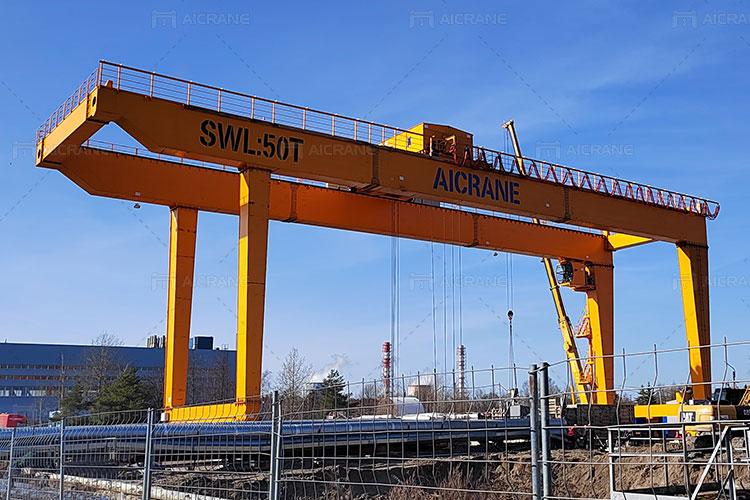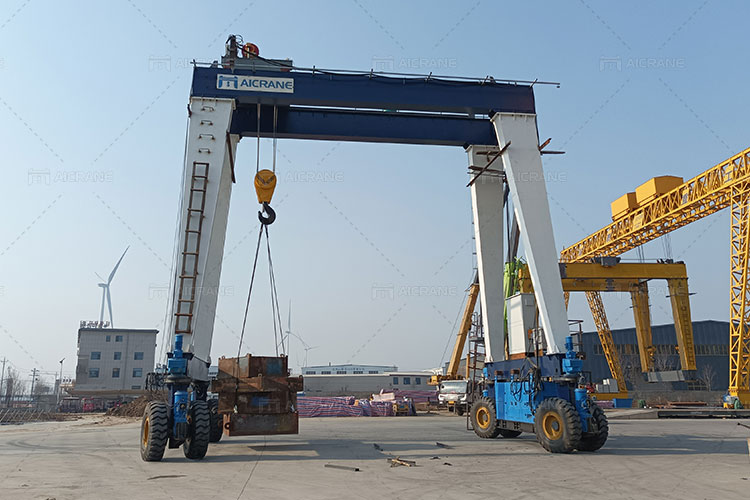When designing a 50-ton gantry crane, mobility and flexibility are two critical factors that can dramatically enhance the efficiency and versatility of operations. Whether the crane is being used in construction, steel manufacturing, port operations, or any other heavy-duty industrial setting, ensuring that the crane can move freely, adjust to different tasks, and adapt to diverse working conditions is essential. This article explores the importance of mobility and flexibility in the design of a 50-ton gantry crane, the key considerations to keep in mind, and how to implement solutions that increase these capabilities without compromising safety, performance, or cost-effectiveness.

Importance of Mobility and Flexibility in Heavy-Duty Gantry Cranes
A gantry crane’s mobility refers to its ability to move along a predetermined path or area, while flexibility is related to its ability to perform a variety of tasks, adjust to different working environments, and accommodate various loads. The need for these qualities in a 50 ton gantry crane is driven by the diverse requirements of industries and the unpredictable nature of many construction or industrial tasks.
In environments such as ports, warehouses, or shipyards, cranes must be able to move materials across vast areas or different sections of a facility. The greater the mobility of the crane, the fewer limitations operators will face in terms of placement and lifting capabilities. Additionally, flexibility allows the crane to be used for different types of loads, whether heavy machinery, containers, or precast concrete elements, without requiring a significant redesign or additional equipment.

Key Design Considerations for Increased Mobility and Flexibility
-
Mobility Options: Rail vs. Rubber Tyred Gantry Cranes
The first decision in designing a 50-ton gantry crane is whether to go for a rail-mounted system or a rubber-tyred solution. Each option offers distinct advantages and can contribute to enhanced mobility.
-
Rail-Mounted Gantry Cranes (RMG): Rail-mounted cranes offer a fixed path for the crane’s movement, which is ideal for industrial settings with specific travel lanes or defined operating areas. Rail-mounted systems are generally more stable, as the crane’s weight is distributed evenly across the rails. This type of design is perfect for environments such as container yards or factories where the crane needs to cover specific tracks. It’s ideal for maximizing the load-carrying capacity and minimizing operational sway.
-
Rubber-Tyred Gantry Cranes (RTG): For greater mobility, rubber-tyred gantry cranes are an excellent option. These cranes are fitted with tyres and can move freely over a variety of terrains. They don’t rely on fixed tracks, which means they can be moved between different operational areas and even on outdoor sites. The flexibility in movement allows these RTG rubber tyred gantry cranes to serve multiple locations, reducing downtime associated with relocating or setting up different equipment for each task.
While rubber-tyred gantry cranes offer more flexibility in terms of movement, they can be less stable compared to rail-mounted systems, especially when lifting heavy loads. Proper design of the tyre system and load distribution mechanisms must be incorporated to ensure the crane remains stable during operation.
-
-
Lift Height and Span Adjustments
A key consideration for flexibility in crane design is the ability to adjust the lift height and span. Gantry cranes with adjustable span widths and lifting heights can be used in a wide range of applications, from lifting tall equipment to moving large, bulky loads. The span refers to the distance between the two supporting legs of the gantry crane, while the lift height defines the vertical distance that the hook or lifting mechanism can reach.
-
Adjustable Span Widths: An adjustable span system allows the crane to change its operational width, providing more flexibility for varying loads and environments. A wider span might be needed for handling oversized materials, while a narrower span is more appropriate for confined spaces. The span system can be designed with hydraulics or mechanical systems to offer quick, efficient adjustments based on the task at hand.
-
Variable Lift Heights: Flexibility in the lift height of a 50-ton gantry crane can accommodate different types of loads. A crane capable of adjusting its lift height allows operators to handle taller objects without needing to move to a different area or bring in additional lifting equipment. This can be particularly useful in construction, warehouse operations, or even marine environments where lifting from boats or ships requires different height configurations.
-
-
Power Supply and Steering Mechanisms
Ensuring that a gantry crane can move smoothly and efficiently is closely tied to its power supply and steering mechanisms. When designing a 50-ton gantry crane for increased mobility, it’s essential to ensure that it can be operated with minimal restrictions in terms of power sources and movement control.
-
Power Supply Flexibility: For maximum mobility, cranes can be designed to work with both electric power and diesel engines. An electric-powered gantry mobile crane can be used in environments where power lines or industrial electric grids are readily available, ensuring efficient operation. Meanwhile, a diesel-powered crane may be used for outdoor, off-grid sites where access to electricity is limited.
-
Steering and Maneuvering Systems: Flexibility in steering is a fundamental aspect of a gantry crane’s design, especially for rubber-tyred cranes. Steering mechanisms like omnidirectional, articulated, and crab steering allow the crane to navigate tight spaces, adjust direction quickly, and move along multiple paths without restrictions. Incorporating advanced steering systems also improves safety by enabling the crane to maneuver around obstacles more easily.
-
-
Operator Comfort and Control
Mobility and flexibility are not limited to the crane’s physical design. The operator’s experience also plays a significant role in ensuring that the crane is easy to control and flexible in its operation. Designing the crane with ergonomics in mind and offering multiple control options will further enhance its efficiency and adaptability.
-
Remote Control Systems: Remote control systems are essential for increased flexibility, as they allow operators to control the crane from a distance, enabling them to navigate around obstacles and fine-tune operations. These systems can be integrated with wireless communication technologies and cameras for enhanced visibility and control.
-
Ergonomic Operator Stations: A comfortable and well-designed operator cabin is essential for ensuring ease of use, especially when operators need to make quick decisions or manage different tasks. Adjustable seats, easy-to-read control panels, and strategic placement of monitors can help operators perform their duties more effectively, enhancing overall flexibility.
-
-
Safety and Stability
Although mobility and flexibility are essential, they should not come at the expense of safety and stability. When designing a 50-ton gantry crane for sale, ensuring that it can maintain its stability during operations, especially when moving large or heavy loads, is crucial.
-
Anti-Sway Technology: This technology helps reduce the lateral motion of the crane, which can occur when lifting heavy or unbalanced loads. Implementing anti-sway systems ensures that the crane maintains stability, even while moving or when adjusting to different tasks.
-
Load Distribution: Effective load distribution mechanisms, such as load sensors and adjustable counterweights, help balance the weight of the crane, especially when operating in different configurations or carrying uneven loads.
-
Conclusion
Designing a 50-ton gantry crane for increased mobility and flexibility is a multifaceted challenge that requires careful consideration of various design elements. By selecting the right mobility options, incorporating adjustable span and lift height, optimizing steering and power systems, and ensuring operator comfort and safety, crane designers can develop a versatile solution capable of handling diverse tasks and environments. The result is a highly efficient, reliable, and flexible crane that meets the demands of modern industries, from construction and manufacturing to port operations and beyond.